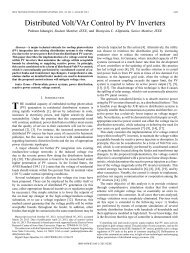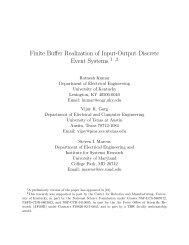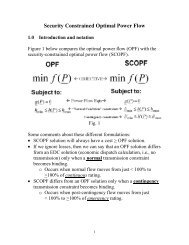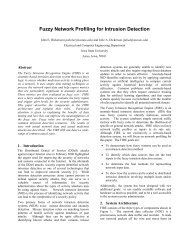Linearized Analysis of the Synchronous Machine for PSS Chapter 6 ...
Linearized Analysis of the Synchronous Machine for PSS Chapter 6 ...
Linearized Analysis of the Synchronous Machine for PSS Chapter 6 ...
You also want an ePaper? Increase the reach of your titles
YUMPU automatically turns print PDFs into web optimized ePapers that Google loves.
(One can alternatively use digital signal processing techniques.)<br />
In <strong>the</strong> phase lead network above, we get that<br />
G lead<br />
V<br />
( s)<br />
=<br />
V<br />
( s)<br />
=<br />
( s)<br />
2<br />
1<br />
R<br />
2<br />
⎧<br />
⎨R<br />
+ ⎩<br />
1<br />
R<br />
2<br />
1 ⎫<br />
⎬<br />
Cs ⎭<br />
where<br />
R<br />
1<br />
+ R2<br />
R1R2<br />
α =<br />
R<br />
, τ = C<br />
R + R<br />
2<br />
1<br />
2<br />
{ R + 1/ Cs}<br />
1<br />
1 + ατs<br />
= α (1 + τ s)<br />
Dorf shows that <strong>the</strong> maximum value <strong>of</strong> phase lead given by <strong>the</strong><br />
above network occurs at a frequency <strong>of</strong><br />
1<br />
ω =<br />
m<br />
τ<br />
α<br />
and <strong>the</strong> corresponding phase lead you get at this frequency is given<br />
by<br />
sin<br />
φ m<br />
α −1<br />
= α + 1<br />
So <strong>the</strong> idea is that you can know <strong>the</strong> frequency ω m that you want to<br />
provide <strong>the</strong> maximum phase lead. This is <strong>the</strong> frequency <strong>of</strong> your<br />
most troublesome electromechanical mode and is considered to be<br />
<strong>the</strong> <strong>PSS</strong> tuning mode.<br />
Note from <strong>the</strong> above diagram that <strong>the</strong> supplementary signal ∆T <strong>PSS</strong><br />
is actually lagging Δω, so one might think that we should provide<br />
phase lag, not phase lead, to <strong>the</strong> input signal (which is actuated by<br />
∆ω). This would in fact be <strong>the</strong> case if we could introduce <strong>the</strong><br />
“shaped” signal (<strong>the</strong> output <strong>of</strong> G lead ) directly at <strong>the</strong> machine shaft.<br />
18
















